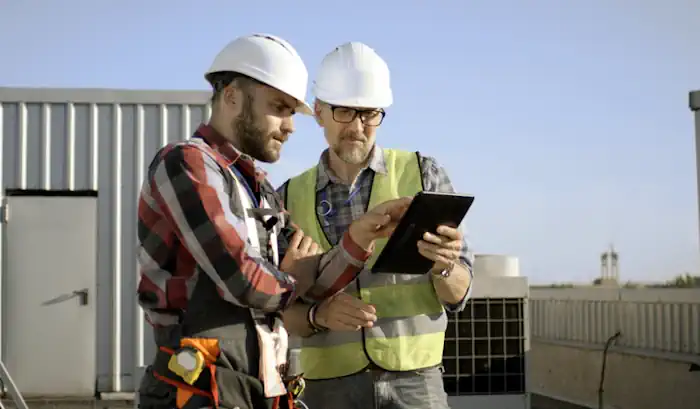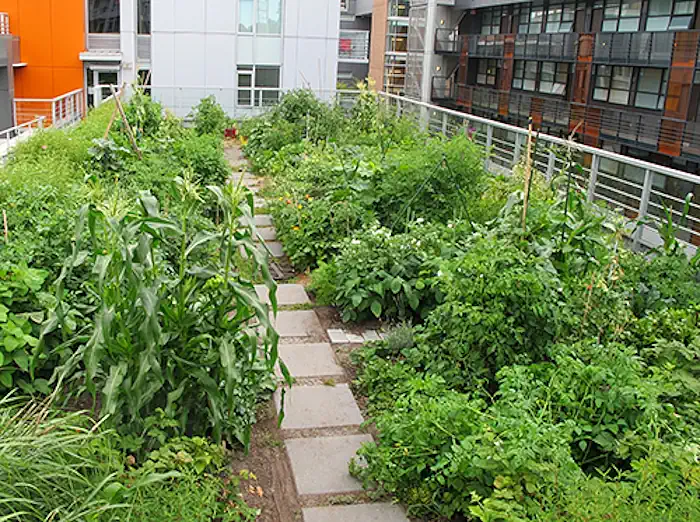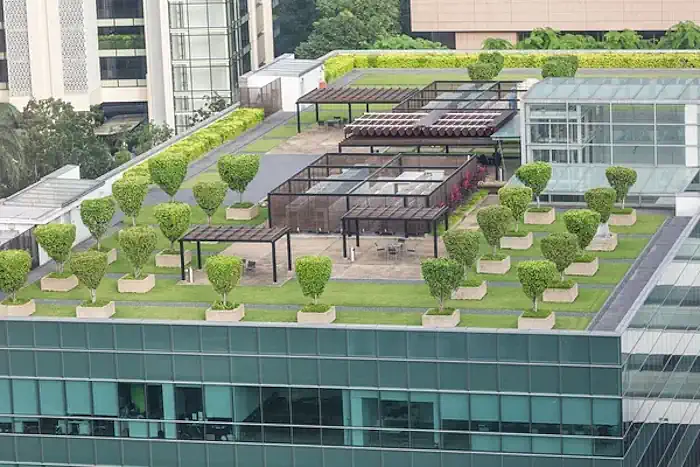Have you ever looked up at a city skyline and wondered if you could transform your flat roof into a lush green oasis? Well, good news! Yes, you can!

Rooftop gardens have become increasingly popular in urban areas, offering a multitude of benefits beyond just aesthetics. From reducing the urban heat island effect to improving air quality and providing food and habitat for wildlife, rooftop gardens can make a significant impact on the environment and quality of life in cities.
But before you start planting, it’s important to understand the structural, environmental, and legal considerations that come with installing a rooftop garden. From assessing the load-bearing capacity of your roof to choosing suitable plants and ensuring proper water management, there are several factors to consider to ensure that your rooftop garden is not only beautiful but also safe and sustainable.
In this article, we will explore the various aspects of installing a rooftop garden on a flat roof, providing you with the knowledge and guidance you need to make an informed decision.
Key Takeaways
- Installing a rooftop garden requires careful consideration of factors such as load-bearing capacity, waterproofing, and proper plant selection.
- Factors to consider for rooftop garden planning include sunlight exposure, wind patterns, microclimate, and zoning regulations.
- Rooftop garden maintenance requires the use of lightweight soil mixes, low-maintenance plants, and irrigation methods to conserve water.
- Safety measures for rooftop garden installation include railings and fire prevention measures, avoiding flammable materials, and meeting weight-bearing capacity requirements.
Benefits of Rooftop Gardens: Exploring the Advantages and Environmental Benefits
You’ll love the advantages and environmental benefits of rooftop gardens, including improved air quality, reduced energy costs, and increased biodiversity.
Rooftop gardens, also known as green infrastructure, are gaining popularity in urban areas around the world. They provide numerous benefits, such as mitigating the urban heat island effect, reducing stormwater runoff, and improving the overall aesthetic of the city.
Urban agriculture is also becoming increasingly popular, and rooftop gardens are a perfect way to incorporate sustainable living practices into city living. They provide a source of fresh produce for the community, reduce the carbon footprint of food transportation, and promote healthy eating habits.
Rooftop gardens are a great way to bring nature back into the city, creating a more livable, sustainable environment for all.
Structural Considerations: Assessing the Load-Bearing Capacity of the Flat Roof
Before you start planning your rooftop garden, it’s essential to assess the load-bearing capacity of your flat roof. The roof structure must be able to support the additional weight of plants, soil, and other components of the garden for an extended period.
Load-bearing assessment is crucial to ensure structural integrity and prevent damage to the building. To determine the load-bearing capacity of your flat roof, you need to conduct an engineering analysis. This analysis will consider various factors such as the type of roof, its age, and condition, as well as the weight of the garden components.

Where do you get an engineering analysis of your flat roof? There are several ways to get an engineering analysis of your flat roof. One option is to hire a professional roofing contractor who specializes in flat roofs. They will assess the condition of your roof, identify any issues, and provide recommendations for repairs or replacement if necessary.
Another option is to hire an engineering firm that specializes in roof analysis. They will conduct a comprehensive analysis of your roof, including structural integrity, drainage, and insulation, and provide a detailed report with recommendations. It is important to choose a reputable and experienced professional to ensure that the analysis is accurate and comprehensive.
The analysis will also take into account the local climate and weather conditions to ensure that the garden can withstand harsh weather events. Once the load-bearing capacity is determined, you can design and install your rooftop garden with confidence, knowing that it is structurally sound and safe.
Waterproofing and Drainage: Ensuring Proper Water Management and Protection for the Roof
Like a ship in a storm, a rooftop oasis must be equipped with proper waterproofing and drainage systems to ensure that excess water does not damage the structure below.
Waterproofing solutions, such as green roof membranes, are essential to prevent water from penetrating the roof and causing leaks. There are a variety of green roof membranes available on the market, including synthetic rubber, thermoplastic, and asphaltic materials. Each type of membrane has its own unique properties, such as flexibility and durability, that make it suitable for different types of rooftop gardens.
In addition to waterproofing solutions, a proper drainage system is crucial for managing water on a rooftop garden. A drainage system should be designed to remove excess water from the roof and direct it to a safe location, such as a stormwater management system or a rain garden.
There are several types of drainage systems available for rooftop gardens, including surface drainage systems, subsurface drainage systems, and combination systems that use both. A well-designed drainage system will not only protect the roof from water damage but also provide a healthy growing environment for plants by preventing waterlogging and ensuring proper soil moisture levels.

A Rooftop Vegetable Garden — Image Source: AbleRoof.com
Safety Considerations: Addressing Safety Measures for Access, Railings, and Fire Prevention
Before you can even begin to plan your rooftop garden, you must be sure that your building meets certain safety codes and regulations. This includes addressing access requirements, railings, and fire prevention.
When it comes to access, you’ll need to consider how you and anyone else who may need to access the rooftop garden will safely get there. This may involve installing a ladder, stairway, or even an elevator depending on the height of your building.
Railings are a necessary safety feature to prevent falls and accidents. These railings must meet certain height and strength requirements set forth by your local building codes.
Fire prevention is also a crucial aspect to consider when installing a rooftop garden. Flammable materials, such as wood or dry leaves, should be avoided in the garden. It’s also important to have a fire extinguisher readily available in case of emergency.
By taking the necessary safety measures, you can enjoy your rooftop garden without worrying about potential hazards.
Legal and Permit Requirements: Understanding Zoning Regulations and Local Building Codes
To ensure that your dream of a green oasis in the sky becomes a reality, you’ll need to navigate the complex legal requirements and permit process associated with creating a rooftop garden that meets zoning requirements and local building codes.
The first step is to research the zoning regulations in your area. Most cities have zoning laws that dictate how structures can be used and where they can be located. You’ll need to make sure that adding a rooftop garden to your building is allowed under these laws.
Once you have confirmed that a rooftop garden is permitted, the next step is to obtain the necessary permits. This involves submitting detailed plans and specifications to your local building department. These plans should include information on the materials you plan to use, the weight of the garden, and how it will be supported.

The building department will review your plans and issue the necessary permits if everything meets the local building codes. It’s important to note that the permitting process can be time-consuming and may require the help of a professional engineer or architect.
Consulting with Professionals: Seeking Expert Guidance for Design, Installation, and Maintenance
Consulting professionals can be a smart move when creating and maintaining a green oasis in the sky. Before you start building your rooftop garden, it’s important to seek expert advice from a structural engineer or an architect. They can assess the weight-bearing capacity of your flat roof and provide you with design planning tips that will ensure your garden is built safely and efficiently.
Frequently Asked Questions
How much weight can a flat roof support for a rooftop garden?
A flat roof can usually support a rooftop garden, but weight must be taken into account during rooftop garden design. Consult a professional to be sure your roof can support the weight of your planned garden, and to take into consideration the maintenance and safety issues for your building.
What is the best type of waterproofing system for a rooftop garden?
To waterproof a rooftop garden, use a membrane system to prevent water infiltration. Drainage options include a layer of gravel, drainage mats, and a drainage layer. Soil composition should be light and porous to promote plant growth and Green roof benefits and to cut down on the weight your roof must support.
Do I need to obtain any permits or approvals before installing a rooftop garden?
Before installing a rooftop garden, it’s important to research permit requirements and legal considerations. Additionally, consider the environmental impact of the garden. Consult with a professional to ensure compliance with regulations and safety standards.
Finally…
You now have a thorough understanding of what it takes to install a rooftop garden on a flat roof. By exploring the benefits, structural considerations, waterproofing and drainage, plant selection and design, maintenance and upkeep, safety considerations, environmental factors, legal and permit requirements, and consulting with professionals, you’re equipped with the knowledge to make informed decisions and create a beautiful rooftop oasis.
As you embark on this exciting project, remember to stay mindful of the environmental impact and safety measures necessary for a successful rooftop garden. With careful planning and attention to detail, you can create a sustainable and visually stunning space that’ll provide numerous benefits for years to come.

As the famous architect Frank Lloyd Wright once said, “Study nature, love nature, stay close to nature. It’ll never fail you.” By installing a rooftop garden on your flat roof, you’re not only connecting with nature but also improving the environment, enhancing your property value, and creating a peaceful retreat, possibly in the heart of the city.
So go ahead, take the leap, and enjoy the beauty and benefits of a rooftop garden.

